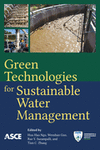Chapter 22
The Resource Economic Dimension of Wastewater Treatment vs. Green Technologies
Publication: Green Technologies for Sustainable Water Management
Abstract
This chapter describes a resource economic approach to evaluate the economic value of the wastewater borne resources, as well as a model to determine the pollution dependent treatment costs for single wastewater parameters. Such a model can be used as an economic steering instrument for strengthening the implementation of green technologies. Wastewater is seen primarily as a source of potentially usable resources rather than a compound of substances that require disposal. The fundamental conditions for a material-specific and partial-stream-specific quantification of wastewater treatment costs are considered as the starting point for the determination of degrees of economic freedom in respect of the future realization of material flow separation concepts. A new approach to evaluation of economic potential of resources contained in the different partial wastewater streams indicates an economic margin, which can be used for a successive introduction of stream separating concepts with subsequent recycling.
Get full access to this article
View all available purchase options and get full access to this chapter.
References
ATV. (1990). “Starverschmutzerzuschläge–Technisch-wissenschaftliche Grundlagen der Gebührenermittlung für industrielle Nutzer öffentlicher Abwasseranlagen. Arbeitsbericht des ATV-Fachausschuss 7.4.” Korrespondenz Abwasser, 37(9), 1075–1079.
ATV-DVWK. (2000). Bemessung von einstufigen Belebungsanlagen, Arbeitsblatt A131, Deutsche Vereinigung für Wasserwirtschaft, Abwasser und Abfall e.V, Hennef.
ATV-DVWK AK-1.1. (2003). “Phosphorrückgewinnung. Arbeitsbericht der ATV-DVWK-Arbeitsgruppe AK-1.1 Phosphorrückgewinnung.” Korrespondenz Abwasser, Abfall, 50(6), 805–814.
BayLfU. (2004). Biogashandbuch Bayern–Materialienband, Bayer, Landesamt für Umweltschutz, Augsburg.
Beier, M. (2003). Kennzahlenbildung und Gebührenermittlung in der Siedlungswasserwirtschaft auf Basis einer systematischen Kostengliederung, Vol. 123, Veröffentlichungen des Institutes für Siedlungswasserwirtschaft und Abfalltechnik der Leibniz Universität Hannover, Hannover.
Dämmgen, U., Döhler, H., Osterburg, B., Lüttich, M., and Eurich-Menden, B. (2005). “Calculations of emissions from German agriculture—National emission inventory report (NIR) 2006 for 2004.” Bundesforschungsanstalt für Landwirtschaft (FAL), Braunschweig.
Dockhorn, T. (2007). Stoffstrommanagement und Ressourcenökonomie in der kommunalen Abwasserwirtschaft, Vol. 74, Veröffentlichungen des Institut für Siedlungswasserwirtschaft, TU Braunschweig, Braunschweig.
Dockhorn, T., and Dichtl, N. (2006). “A decision support tool for implementing a sustainable resource management in the sector of municipal wastewater treatment.” Water Environ. Manage. Ser., 10, 57–66.
Durth, A., and Schaum, C. (2005). “Ergebnisse der DWA-Klärschlammerhebung 2003.” Vol. 4, DWA Klärschlammtage, Würzburg, Germany.
EFMA (European Fertilizer Manufacturers Association). (2000). “Phosphorus essential element for food production.” 〈http://www.efma.org〉 (Dec. 8, 2000).
EFMA (European Fertilizer Manufacturers Association). (2005). “Understanding nitrogen and its use in agriculture.” 〈http://www.efma.org〉 (Sep. 30, 2005).
Elmitwalli, T. A., Oahn, K. L. T., Zeemann, G., and Lettinga, G. (2002). “Treatment of domestic sewage in a two-step anaerobic filter/anaerobic hybrid system at low temperature.” Water Res., 36(9), 2225–2232.
Falbe, J., and Regitz, M. (1995). Römpp Chemie Lexikon, Vol. 9, Thieme Verlag, Stuttgart.
Frede, H. G. (2005). “Nährstoffversorgung der Böden in Deutschland.” 38, Essener Tagung für Wasser- und Abfallwirtschaft, Schriftenreihe Gewässerschutz-Wasser-Abwasser, Vol. 198, Aachen, 72.1–72.9.
German Federal Statistical Office, Statistisches Bundesamt. (2001). “Statistisches Jahrbuch 2001, Für die Bundesrepublik Deutschland und für das Ausland.” Wiesbaden.
German Federal Statistical Office, Statistisches Bundesamt. (2003). “Umwelt–öffentliche Wasserversorgung und Abwasserbeseitigung, Fachserie 19 Reihe 2.1.” Wiesbaden.
Gethke, K., Herbst, H., Montag, D., and Pinnekamp, J. (2005). “Potenziale des Phosphorrecyclings aus Klärschlamm und phosphathaltigen Abfallströmen in Deutschland.” KA-Abwasser Abfall, 52(10), 1114–1119.
Gumbo, B., Savenije, H. H. G., and Kelderman, P. (2002). “Ecologising societal metabolism: The case of phosphorus.” Proc., 3rd Int. Conf. on Environmental Management, Västeras, Sweden.
Günthert, F. W., and Reicherter, E. (2001). “Investitions- und Betriebskosten bei der Abwasserreinigung.” Kostenanalyse und Kostensteuerung in der Abwasserwirtschaft, ATV-DVWK, Hennef, 5.1–5.28.
IFEU. (2005). “Beitrag der Abfallwirtschaft zur nachhaltigen Entwicklung in Deutschland, Teilbericht Siedlungsabfälle.”, UFO-Plan-Vorhaben, Umweltbundesamt, Berlin.
IKW (Industrieverband Körperpflege- und Waschmittel e.V.). (2003). “Erhebung der Einsatzmengen bestimmter Inhaltsstoffe von Haushalts-, Wasch-, -Putz/Pflege- und Reinigungsmitteln zum Einsatz in Deutschland von 1994-2003.” Frankfurt/Main.
IVA (Industrieverband Agrar). (2005). “Agrar Jahresbericht 2004/2005.” 〈http://www.iva.de〉 (Sep. 30, 2005).
Johnston, A. E. (2005). “Understanding potassium and its use in agriculture.” 〈http://www.efma.org〉 (Sep. 30, 2005).
Lüttich, M., Eurich-Menden, B., Osterburg, B., Dämmgen, U., and Döhler, H. (2004). “Calculations of emissions from German agriculture-national emission inventory report (NIR) 2004 for 2002 pt. 2, tables.” Landbauforschung Völkenrode, Sonderheft, 260, 33–198.
Maurer, M., Schwegler, P., and Larsen, T. A. (2003). “Nutrients in urine: Energetical aspects of removal and recovery.” Water Sci. Technol., 48(1), 37–46.
Müller, E. A., Kobel, B., Künti, T., Pinnekamp, J., Seibert-Erling, G., and Böcker, K. (1999). Handbuch–Energie in Kläranlagen, Ministerium für Umwelt, Raumordnung, und Landwirtschaft des Landes Nordrhein, Westfalen, Düsseldorf.
NKAG (Niedersächsisches Kommunalabgabengesetzt). (2005). “In der Fassung der Bekanntmachung vom 11. Februar 1992 (Nds. GVBl. S. 29) zuletzt geändert durch Artikel 5 des Gesetzes vom 15.” GVBl, 342.
Otterpohl, R., and Oldenburg, M. (2002). “Innovative Technologien zur dezentralen Abwasserbehandlung in urbanen Gebieten.” Korrespondenz Abwasser, 49(10), 1364–1371.
Patyk, A., and Reinhardt, G. A. (1997). Düngemittel–Energie- und Stoffstrombilanzen, Vieweg Verlag, Braunschweig.
Schnug, E., Rogasik, J., and Haneklaus, S. (2003). “Die Ausnutzung von Phosphor aus Düngemitteln unter besonderer Berücksichtigung des ökologischen Landbaus.” Landbauforschung Völkenrode, 53(1), 1–11.
Seyfried, C. F., and Scheer, H. (1993). “Sind Starkverschmutzerzuschläge für Indirekteinleiter im Hinblick auf N- und P-Elimination noch sinnvoll?” Korrespondenz Abwasser, 40(7), 1132–1137.
STN. (2005). “Servicegesellschaft tierische Nebenprodukte mbH.” 〈http://www.stn-vvtn.de〉 (Sep. 23, 2005).
Wagner, M. (2005). “Rohphosphat–Verfügbarkeit und Verbrauch.” 38, Essener Tagung für Wasser- und Abfallwirtschaft, Schriftenreihe Gewässerschutz-Wasser-Abwasser, Vol. 198, Aachen, 71.1–71.11.
Information & Authors
Information
Published In
Copyright
© 2016 American Society of Civil Engineers.
History
Published online: Jul 1, 2016
ASCE Technical Topics:
Authors
Metrics & Citations
Metrics
Citations
Download citation
If you have the appropriate software installed, you can download article citation data to the citation manager of your choice. Simply select your manager software from the list below and click Download.
